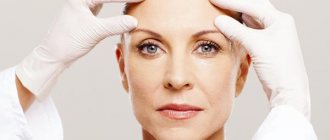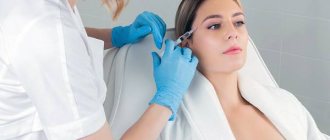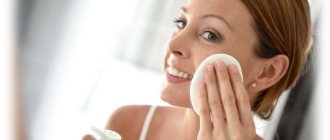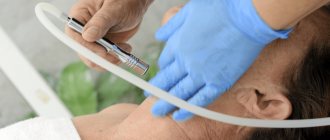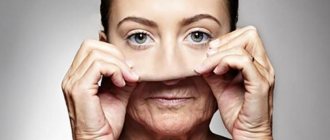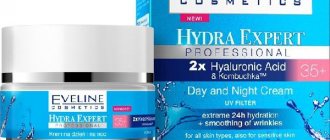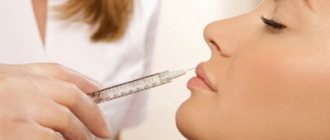To preserve youth and maintain healthy skin, modern cosmetology offers many minimally invasive procedures with maximum benefits and minimal risk of unwanted consequences. One of them is hyaluronic acid injections. This substance is capable of many things; its use allows you to carry out many procedures for different skin types for almost any problem. Contour plastic surgery, mesotherapy and biorevitalization are performed in cosmetology with the participation of hyaluronic acid.
Hyaluronic acid injections are a minimally invasive alternative to plastic surgery with a lower risk of unpleasant consequences, faster skin restoration and lower cost.
Types of procedures with hyaluronic acid
Pure hyaluronic acid is not used in cosmetology; injections are carried out using a special gel containing low molecular weight acid. The substance has an amazing skin healing effect and a quick onset of results.
There are several methods for introducing low molecular weight acid in cosmetology.
- Biorevitalization, or microinjections (best suited to the definition of “beauty injections”) is a method of delivering a beneficial substance into the deep layers of the skin to eliminate microcracks, shallow age-related wrinkles and to correct the contour of the face. The drug is injected a few millimeters with a thin needle; minor adverse reactions may occur after the procedure.
- Mesotherapy involves the delivery of useful substances using a special roller with small needles onto which the drug is applied. Helps get rid of stretch marks, small scars and scars.
- Injections are the most traumatic technique; they differ from microinjections in the depth of insertion of the syringe. It is used to influence the deep layers, where natural hydration and nutrition of the epidermal tissues occurs, and is indicated for tightening, changing the contour, and enlarging the lips.
For each procedure, one of two types of hyaluronic acid can be used - monophasic and biphasic fillers. In the first case, the drug is used primarily for contouring: lip augmentation, changing the shape of the forehead, cheekbones, and tip of the nose. Two-phase fillers (“Restylane”) are preparations with 1 g of gel; they are used for deep correction to quickly restore skin elasticity.
Fillers for fillers
Long-acting and permanent-acting drugs are used for injections. They differ in composition and administration technique. Long-acting preparations contain 2 main components - hyaluronic acid and collagen. They compensate for the lack of natural substances, which is accompanied by dry skin, loss of elasticity and the appearance of wrinkles. Natural collagen is an element of connective tissue, and hyaluronic acid is contained in the intercellular space, providing hydration.
The duration of the effect largely depends on the combination of drugs. The introduction of collagen alone gives results for 3-4 months, with hyaluronic acid - for 5-7 months.
Semi-permanent or long-acting preparations are indicated to eliminate deep wrinkles and folds. They are microsphere particles or gel. The effect of their use lasts for 12-18 months.
Consequences of hyaluronic acid injections
Injections with hyaluronic acid may immediately give no side effects. The negative effects of the drug on the body can manifest themselves after some time. If the patient has a natural predisposition to diseases of the dermis, then the administration of the drug can be an impetus for activation. The introduction of hyaluronate can provoke the development of autoimmune diseases: psoriasis, lichen planus, systemic lupus erythematosus.
Also, injections of the functional component tend to initiate abnormal cytological division. An increase in the level of sodium hyaluronate in the body can cause the appearance of benign formations. The introduction of a substance into the dermis can affect other nearby tissues. In contact with subcutaneous fatty tissue, hyaluronic acid causes its growth and thickening.
An increased concentration of hyaluronates in the body leads to an increase in the synthesis of enzymes that break them down. But the problem is that malignant tumors also contain excessive amounts of hyaluronic acid. Therefore, the active enzyme begins to dissolve not only hyaluronic acid, but also the malignant tumor and tissues adjacent to it. Because of this, cancer cells enter the bloodstream and spread throughout the body.
To minimize the negative impact of hyaluronic acid on the body, it is recommended to use formulations based on it only externally. This will reduce the concentration of the component to a minimum and prevent unforeseen consequences.
Operating principle
The filler contains several active components, each of which has a separate positive effect on the skin. Additional substances in the composition are also necessary to accelerate the activation of hyaluronic acid and its better acceptance by the body without adverse reactions.
Getting under the skin, the substances create an invisible frame that evens out the skin texture and fills the deep layers with looped substances. A number of reactions in response to the ingestion of the drug lead to an amazing effect - the skin glows with health, wrinkles disappear, and color improves.
The results of one procedure can last up to two years, which cannot be achieved with many other techniques with hyaluronic acid. Superficial application of a substance to the skin usually cannot affect the processes inside, therefore the rejuvenation effect is weak or completely absent. In case of a serious defect, cosmetologists will recommend an injection. The drug will go directly to the problem area and remain there until it is gradually eliminated naturally.
Hyaluronic acid can be administered in different concentrations and quantities depending on the purpose. More of the drug will be needed when it is necessary to perform plastic surgery or size correction of certain areas of the face. A smaller amount of the substance is used for injection during biorevitalization and mesotherapy, when it is necessary to remove small wrinkles.
Types of anti-aging procedures
- The most popular anti-aging procedure with hyaluronic acid is biorevitalization, which is a type of mesotherapy. Biorevitalization is performed only with hyaluronic acid, and this procedure can be done by the age of 30-40, while mesotherapy can be carried out even at 18 years.
- For mesotherapy, various components are often used, from which a special cocktail is made. The greatest effect from mesotherapy occurs after several procedures, while biorevitalization has an immediate effect.
- Botox injections, which are carried out once every two years, will help rejuvenate the skin and get rid of deep wrinkles after 30 years. Botulinum toxin promotes facial rejuvenation and muscle relaxation, resulting in smoother skin and disappearance of wrinkles. It must be remembered that if administered incorrectly under the skin, Botox can have negative consequences in the form of immobility of facial muscles.
All these techniques are the best alternative to plastic surgery and help maintain facial skin in good condition, but most often preference in cosmetology is given to biorevitalization.
Indications for injections
Injections with hyaluronic acid are worth doing if there are certain indications or at the request of the woman.
You can take a rejuvenating course if you have the following appearance flaws:
- Signs of skin aging;
- Nasolabial folds;
- Expression wrinkles;
- Decreased tone;
- Dry skin;
- Scars or welts;
- Bags under the eyes;
- Age above 30-40.
After a course of injections, the face looks fresh, skin pigmentation disappears, wrinkles are eliminated, and the relief is evened out. Under the influence of hyaluronic acid, collagen production is activated and skin cells are renewed, so it becomes elastic and toned.
A special cocktail, after being introduced into the skin, helps fill nasolabial folds and vertical wrinkles, remove asymmetry or other defects.
Stages of the procedure
Biorevitalization with injection of hyaluronic acid is carried out according to the following algorithm:
- skin cleansing;
- anesthesia;
- administration of the drug;
- skin treatment, application of a soothing agent.
Injections are performed under local anesthesia. The face must be cleansed before the main procedure, for which antibacterial agents are used. After injections, the skin is treated with an antiseptic.
The duration of the procedure may vary in each case - it depends on the individual characteristics of the skin and the technique of execution. Typically biorevitalization lasts from 20 to 60 minutes. At the end of the session, the cosmetologist gives recommendations on skin care during the recovery period, after which you can go home.
How is biorevitalization done?
Usually, it is recommended to give injections to the face with a biodegradable filler, which has an effect similar to contour plastic surgery. These fillers include Juvederm, Restylane and other products with hyaluronic acid. This injection substance is obtained by biosynthesis; it can have varying degrees of density. For mesotherapy, a cosmetologist can select homeopathic remedies, vitamins, plant extracts, medicines or synthesized drugs.
Procedure steps:
- Skin cleansing;
- Anesthesia;
- Injections;
- Re-processing of leather.
Injections in the face must be made under local anesthesia, with the exception of gels that initially contain lidocaine or another anesthetic substance. Local anesthesia can be infiltration or conduction.
The face must first be cleaned of makeup and wiped with an antibacterial agent to avoid skin inflammation and infection. At the end of the procedure, the cosmetologist re-treats the skin with an antiseptic.
How long the session will last depends on the injection technique or individual skin problem. In total, the rejuvenating procedure can take from 15 minutes to an hour. All manipulations can be done on an outpatient basis, going home the same day. First, the cosmetologist should tell you what consequences usually occur after injections and how long they can last.
After the session it is prohibited:
- Be in direct sunlight;
- Visit a solarium, sauna or swimming pool;
- You should not use cosmetics or peel for several days until the skin is restored.
Indications
The introduction of hyaluronic acid is effective for a number of skin problems and for their prevention:
- processes of physiological aging - facial wrinkles, crow's feet, displacement of the cheeks, loss of elasticity, changes in facial oval;
- mild non-inflammatory dermatological diseases - keratosis, acne, post-acne, poor skin hydration, peeling;
- the desire to enlarge lips, give shape to cheekbones, forehead, cheeks - the drug helps to achieve a beautiful facial contour, acid is often used to correct other parts of the body;
- deep wrinkles in the nasolabial fold, forehead, under the eyes.
Injection results: Smoothing wrinkles, adding volume to lips, cheekbones
All injection procedures for rejuvenation are quite effective. The main result of a course of HA injections is, of course, the smoothing of wrinkles: they either disappear completely or become much less pronounced.
Injections eliminate any wrinkles: both facial and age-related, and also smooth out formed folds.
Injections of hyaluronic acid, photos before and after of which are presented below, also eliminate other skin problems. HA hides sagging facial skin well - injections allow you to add volume to your cheekbones, filling them out.
Hyaluronic acid forms the correct shape of the lips, making them fuller.
Injections of hyaluronic acid are also given to the lips to give them fullness.
Contraindications
In some cases, hyaluronic acid for the face is not the best option. Doctors prohibit injections in the following cases:
- the period of pregnancy and breastfeeding, which is associated with changes in hormonal levels and the risk of filler migration under the skin;
- period of exacerbation of chronic diseases, the presence of fungal and bacterial infections, open wounds on the skin;
- bleeding disorders and other diseases of the hematopoietic organs;
- autoimmune diseases;
- hypersensitivity to hyaluronic acid and other substances in the injection preparation.
Important!
Carrying out the procedure at home is contraindicated - many girls take risks, after which cosmetologists have to eliminate the serious consequences of injections, which is often associated with nerve damage, uneven administration of the drug and infection under the skin. This can manifest itself as terrifying wounds on the face, rashes, and changes in shape not in the desired direction.
Biorevitalization with preparations with zinc
In order to achieve maximum rejuvenation effect, preparations based on hyaluronic acid are enriched with zinc. The most common drug of this type is Outline “Mesolift”.
Beneficial properties of zinc
Zinc is a substance necessary for the normal functioning of the body. It is responsible for cell regeneration and fatty acid processing. In addition, a sufficient content of this substance will help you forget about such unpleasant things as allergic rashes, dehydration of the skin, and the appearance of numerous wounds and cracks. Zinc can also prevent the early appearance of facial wrinkles.
Outline Mesolift Zn +
This drug is a strong medicinal antioxidant. This drug, due to the high content of zinc salt in its composition, is able to moisturize the skin of the face and also stimulate neocollagenous processes. Using Outline Mesolift Zn + at home is impossible. The effect after the biorevitalization procedure with the above-mentioned drug will appear no earlier than after 2 weeks. This is exactly the amount of time needed for the facial skin to shrink and the long-awaited lifting effect to appear. The full course lasts 4 months, and the procedure can be repeated no more than 2 times a month.
Effect of the drug
Carrying out the biorevitalization procedure with the drug Outline Mesolift Zn + promotes noticeable rejuvenation and tightening of the skin. The high content of antioxidants in this drug activates collagen synthesis and also stimulates the activity of fibroblasts. In addition, zinc is an excellent antiseptic. That is why after this cosmetic procedure, the likelihood of inflammation on the skin of the face and décolleté is noticeably reduced.
Reviews of the drug Outline Mesolift Zn +
On the Internet you can find many positive reviews about this drug. The most interesting are the opinions of professional cosmetologists. They say that Outline Mesolift Zn is easy to use and easy to dose. In addition, 95% of visitors, after undergoing a biorevitalization procedure with hyaluronic acid, noticeably reduce dark circles under their eyes, increase skin elasticity and firmness, and eliminate fine expression wrinkles. According to cosmetologists, allergic reactions to the drug are extremely rare. The only drawback is the strong unpleasant odor, which does not disappear for a very long time.
Modern cosmetology offers a lot of means to combat the visible causes of aging. From this article you could learn about how hyaluronic acid with zinc for biorevitalization affects the condition of the skin. The most commonly used drug for this procedure is Outline Mesolift Zn +. According to cosmetologists, this medicine can visually make you several years younger.
At what age can you inject hyaluronic acid?
Cosmetologists recommend resorting to this procedure when the need arises - after 30 years. But due to individual characteristics and negative factors affecting the skin, aging can begin at the age of 25. At different ages, other fillers with different concentrations of hyaluronic acid are used.
Advice
It makes no sense to give injections before the age of 25, so cosmetologists recommend taking care of the skin with non-invasive cosmetic procedures - non-injection mesotherapy and other gentle techniques - until this age.
The following factors can lead to the early appearance of wrinkles and deep folds:
- polluted air and water;
- stressful situations, emotional tension;
- active facial expressions;
- lack of sleep, insomnia, frequent changes in sleep and wakefulness;
- genetic predisposition;
- consumption of alcoholic beverages, energy drinks, coffee;
- smoking and taking drugs.
Drugs
Injections with hyaluronic acid are carried out with specialized preparations - fillers.
Filler is an injectable product based on biosynthesized hyaluronic acid. The most widely used are:
- Juvederm is a drug manufactured in the USA, used in contouring to eliminate age-related changes of various levels;
- Restylane (L) is an American remedy for eliminating deep wrinkles, folds and pronounced age-related changes in the face;
- Estelis is a Swiss-made filler preparation that has a targeted effect on facial rejuvenation and contains an additional active substance - collagen;
- Princess is an Austrian drug, most popular for facial rejuvenation procedures;
- Surjirem is a French contouring product based on a three-dimensional hyaluronic acid matrix;
- Puragen - produced in the UK, is considered one of the best drugs for filling wrinkles and replenishing lip volume, contains an anesthetic substance;
- Ivor Hydro is a French filler for solving specific rejuvenation problems; it retains the rejuvenation effect for a long time, making the skin young and attractive.
Restrictions after the procedure and adverse reactions
In the first days after injections, it is recommended to adhere to the following rules:
- do not wash your face with hot water, avoid exposure to hot steam on your face;
- refuse to visit the solarium, bathhouse, sauna;
- on the first day, do not go out into the open sun, avoid wind and drafts;
- Do not use facial scrubs or preparations containing alcohol under any circumstances.
After the face is injected, local reactions appear, which should not be scary. They are a normal response to puncture of the skin and injection of various substances. Immediately after the procedure, you may experience swelling, redness, and a feeling of discomfort. This reaction can last several hours or drag on for 2-3 days. This will be considered normal if the listed symptoms are not accompanied by other signs. Complications will be indicated by a sensation of pulsation, the appearance of hematomas, severe redness of the skin, itching and burning.
After a few days, but more often within 24 hours, the following complications may develop:
- severe tissue swelling;
- rupture of small vessels;
- granuloma;
- pronounced redness;
- development of infection.
Hematomas appear as a result of a needle entering a vessel. In this case, the cosmetologist will prescribe absorbable medications, but the bruise may take a long time to disappear, several weeks, depending on the size. Usually, heparin ointment is prescribed to eliminate the hematoma.
Less commonly, after injection of hyaluronic acid, rejection of a foreign substance can be observed, which manifests itself in the form of the appearance of fibrous capsules and granulomas. This complication is always accompanied by an inflammatory process, so comprehensive treatment is required. Surgical remediation may be required.
Complications after injections in the face
Regardless of how old a woman is or what type of skin she has, immediately after the injections, slight swelling of the tissues may occur, which lasts for several days. This consequence of the injection is associated with the reaction of the skin to needle punctures and injection of the drug. In addition, minor pain may be bothersome, which can be relieved with analgesics.
Types of complications:
- Hematomas;
- Tissue swelling;
- Redness;
- Vessel embolism;
- Granulomas.
After the injection, you may encounter hematomas that occur on the face when the needle enters a blood vessel. This consequence can be eliminated with the help of heparin or other absorbable ointment. In some cases, filler rejection may occur and manifest as granulomas or fibrous capsules. This complication is accompanied by an inflammatory process and requires special surgical treatment.
If the rules of asepsis are not followed, there is a possibility of getting inflammation of the skin, which can be treated with antibiotics and anti-inflammatory drugs. If the gel was introduced incorrectly (superficial injection), irregularities or bumps may remain on the skin. This complication can be corrected with repeated injections of a drug that can break down hyaluronic acid (hyaluronidase).
In rare cases, after a rejuvenation session, a vessel embolism may develop. At the same time, the facial skin becomes too red and swollen, and in the future you can get tissue necrosis or scars. You can prevent such complications if you exclude possible contraindications in advance and contact an experienced specialist in a good beauty salon.
Things to consider
- It is quite difficult to maintain facial skin in normal condition using simple cosmetics or massages, so techniques such as biorevitalization or mesotherapy are usually used. In order to achieve maximum results, injection components should be selected taking into account the characteristics of facial skin, the number of wrinkles and other factors.
- What the result will be after the procedure, in most cases depends on the cosmetologist who performs the injections. Therefore, it is recommended to contact only an experienced specialist who has extensive experience. Correct behavior during the rehabilitation period and compliance with all the cosmetologist’s recommendations will also help reduce the risk of complications.
- After using hyaluronic acid (mesotherapy, biorevitalization), it is recommended to undergo anti-inflammatory and immunomodulatory therapy. They will help provide the skin with additional protection from environmental influences. If you are allergic to some components of the injections, you should use single medications that will help prevent the development of an allergic reaction.
- In addition, the cosmetologist must find out possible contraindications to the anti-aging procedure in order to avoid complications or negative consequences. You should start with simple vitamin preparations and then gradually move on to stronger preparations with hyaluronic acid.
- After a course of anti-aging injections, it is advisable to use special cosmetics prescribed by a cosmetologist; they will help to consolidate the results for a long time.
Contraindications
It is prohibited to perform anti-aging injections if:
- Pregnancy;
- During the lactation period;
- If there is a blood clotting disorder;
- In case of skin disease;
- With exacerbation of herpes;
- If you are allergic to components;
- When taking certain medications;
- For viral diseases, especially herpes;
- If you are prone to keloid scars;
- For any infectious disease.
It is important(!) From what age and whether it is worth using injection methods of rejuvenation at all, only a doctor can decide. Only a specialist can decide whether injections are needed at all, and if so, which technique is right for you.
Advantages and disadvantages
Arguments in favor of hyaluronic acid injections:
- contour plastic surgery using hyaluronic acid is considered the safest method for rejuvenating and correcting the shape of the face;
- the result of one session lasts for more than a year, the substance is eliminated independently, there is no need to resort to surgical interventions;
- the effect of the procedure is visible immediately, you don’t have to wait several months for positive changes to appear, one procedure is enough;
- the combination of hyaluronic acid and collagen allows you to stop the aging process of the skin, remove wrinkles of any depth, regardless of age and skin type;
- acne is not a contraindication - the cosmetologist only works with greater caution, and hyaluronic acid helps cleanse the dermis, which speeds up the healing of pimples and blackheads and prevents their reappearance;
- rejuvenating injections replenish the lack of moisture, which gives freshness and health, while at the same time tissues are nourished at a deep level;
- injections accelerate the elimination of toxic substances, have an anti-inflammatory effect and stimulate the restoration of damaged cells.
Hyaluronic acid injections also have their disadvantages.
- Injuring the skin is always undesirable, and the method involves making several punctures.
- There is a risk of the formation of various compactions in the puncture area - papules, granulomas, and nodules may appear.
- There is always a risk of skin infection, fungal or bacterial infection, which already entails a number of specific diseases.
- The development of an allergic reaction and drug rejection when combining different substances to which there may be hypersensitivity.
- Exacerbation of chronic diseases, activation of latent infection, appearance of multiple papillomas and warts.
The most unpleasant phenomenon after the injection of hyaluronic acid can be protrusion of the filler. This occurs due to incorrect technique for administering the substance. Swelling after a cosmetologist’s mistake can only be eliminated surgically. Correction of the consequences is carried out in specialized beauty salons by plastic surgeons.
Contraindications for hyaluronic acid injections
Most women agree to undergo procedures, as well as operations with the final anti-aging and effective result, mainly driven by the desire to prolong their twenty-year youth, and to have a well-groomed and beautiful face.
What are the risks?
A large number of cosmetics are not able to give the same effect as, for example, after surgery.
And women are looking for new ways to combat these expression lines. This product has quite strict contraindications. The risk is associated with the natural origin of the drug, because hyaluronic acid is of animal origin, and can also be biosynthesized or artificial.
During the session, there is an invasion of the natural processes of the vital activity of the skin, therefore absolutely all methods and techniques have a large number of contraindications.
If you do not follow and adhere to the rules of asepsis, the consequences can be very serious. The technique of performing the procedure is also important. All injections must be carried out exclusively in clinics or beauty salons that have the necessary rights to conduct these sessions.
Despite all its advantages and beneficial properties, hyaluronic acid is considered a drug, which means that it also has serious contraindications.
Cases when hyaluronic acid should not be used
Inflammatory processes inside the body and acute forms of diseases. This also applies to those people who have problems with blood clotting, skin infections or problems with connective tissue;- If the substance is poorly purified, which can lead to quite serious severe autoimmune diseases if we are talking about biosentified hyaluronic acid;
- For oncological diseases;
- For diabetes mellitus;
- We recommend that pregnant and nursing mothers postpone injections for a short time during this period of time;
- If you used products of animal origin, there is a high probability of an allergic reaction. And most importantly, the immediate disappearance of the effect of the procedure performed, because natural remedies are eliminated much faster than others.
Consequences of injections
Preparations containing hyaluronic acid are medical products, therefore all sessions must be carried out under the supervision of a qualified specialist. He must first select the required drug, injection methods, and dosage, but only after examining and assessing the patient’s skin. The final result largely depends on the qualifications of the specialist, so we recommend that you contact reliable, proven and experienced cosmetologists, look at reviews of their work.
The number of sessions depends on your skin condition.
Naturally, the first session will not be enough when it comes to wrinkles in the eye area. According to highly qualified specialists, about four injections need to be done, and to correct the shape of the face, about eight injections. After completing the course, after a period of 6 months, this course should be repeated in order to obtain a more lasting final result.
Each medical procedure has its own risks, because by giving injections, doctors violate the integrity of our skin, which is why various kinds of infections can penetrate into our skin if there are, for example, wounds, scratches or cuts. Basically, the drug is administered locally, but no one can say what your body’s reaction will be. Before deciding on such a procedure, you should know what side effects and contraindications there are.
Side effects
Scars may appear at the puncture sites;- The formation of granulomas, oleomas, papules, various thickenings and compactions that can form due to the introduction of large doses into the layers of the epidermis;
- Activation and exacerbation of various kinds of processes in the body is possible;
- Bactericidal and fungal infections may develop; in the worst case, abscesses and necrosis on the skin;
- The formation of bruises and bruises is often associated with incorrect technique of performing the procedure.
Important features of the procedure
What should you know before undergoing anti-aging injections?
- Injections can always be avoided by familiarizing yourself with non-invasive cosmetic procedures and consulting with an independent specialist.
- A cosmetologist cannot guarantee the complete safety of the procedure and the absence of complications. If the specialist assures that everything will be 100% successful, it is better to look for another salon.
- Before biorevitalization and mesotherapy, many doctors recommend taking an immunomodulating and anti-inflammatory course and taking vitamins to minimize the risk of an unwanted reaction.
- During the preliminary consultation, it is worth checking with the cosmetologist every detail of the preparation, conduct of the procedure and rehabilitation after it, in order to plan your time and do everything correctly before and after rejuvenating injections.
- The first time after the injections, you will need to use special cosmetic preparations, and this also needs to be checked with a cosmetologist in advance in order to prepare everything in advance.
Hyaluronic acid injections have their own advantages and disadvantages in each individual case, and it is important to learn about them before the session. Many people consider injections unsafe and try in every possible way to prove this with unsubstantiated statements about the dangers of such a procedure. In fact, every technique in cosmetology has risks and can result in serious health consequences. Cosmetologists try to make each procedure as comfortable and safe as possible. Proper preparation with a willingness to deal with unforeseen problems is the key to successful beauty injections.
Removing wrinkles with fillers
Good afternoon. Today I will answer basic questions about smoothing wrinkles with hyaluronic acid and how to care for your face after injections.
Let's start with the most important question-misconception:
What to choose: gels or fillers?
This is a popular question, but for cosmetologists it is absurd, because they are the same thing. Filler is a dermal filler for contouring in the form of a gel. In 90% of cases, a gel based on hyaluronic acid is used!
What are the benefits of hyaluronic acid?
Hyaluronic acid is a natural component of the body that is responsible for skin hydration and elasticity. Until the age of 25, the amount of hyaluronic acid in the body is normal, but with age it decreases. Preparations based on hyaluronic acid compensate for the lack of hyaluronic acid in cells and they are practically non-allergenic, which is why they are so popular in cosmetology.
Application of hyaluronic acid
Fillers will help you:
- Tighten the skin of the face and body;
- Smooth out nasolabial folds;
- Smooth out wrinkles between the eyebrows;
- Smooth out wrinkles in the décolleté area;
- Change the shape and volume of the lips;
- Change the shape of your cheeks, nose and chin;
- Fill the nasolacrimal grooves;
- Fill the periobital area;
- Correct age-related changes in the face, hands, décolleté and body (appearance of wrinkles, loss of volume);
- Restore lost volume in the cheeks, cheekbones, temporal region, chin;
- Smooth out atrophic scars;
- Enlarge and shape the oval of the face at a young age;
- Cope with lipoatrophy, facial lipodystrophy;
What you need to know about lip augmentation with fillers.
How often should hyaluronic acid injections be given?
The effect of haluronic acid injections lasts all year. A repeat procedure will be required after 8–12 months, depending on the individual characteristics of the body and compliance with facial care conditions.
I WANT THE SAME
Which filler should I choose?
You should not choose the filler yourself. Only a cosmetologist-dermatovenerologist will select a preparation of a suitable concentrate and density to achieve the result you want, taking into account the characteristics of your body.
Contraindications to fillers
Contraindications for filler injections are standard: injections should not be given to people with rheumatism; with exacerbation of chronic inflammatory diseases in the head area (pharyngitis, stomatitis, etc.); suffering from diabetes mellitus; pregnant and lactating women.
Does hyaluronic acid injections hurt?
Injections with hyaluronic acid are quite unpleasant, they feel like tingling. If you have a low pain threshold, then before smoothing out wrinkles it is better to have anesthesia, because when using an anesthetic, filler injections are painless. At the clinic we use conduction and topical anesthetics.
There are medications that already contain anesthetics, but they can cause allergies in you, which is why we do not use such medications.
The day after the procedure, your lips may become dry. This is due to the anesthetic. In this case, use a moisturizing balm as needed (until the dryness goes away).
How many units of hyaluronic acid do you need?
This depends on the “depth” of the wrinkles and the effect you want to achieve. On average, 0.5 to 1.5 ml of gels are required. You will find out the exact value during a consultation with a cosmetologist, he will also select gels that are suitable in density.
I WANT THE SAME
How long does it take to heal after hyaluronic acid injections?
After injections, there may be swelling, bruising, pain at the injection site and a sensation of a foreign substance. If after the injection no hematomas or swelling have formed, then the lips will heal within 2–3 days. The bruises will go away in 3–5 days. Healing time will be reduced if you use soothing creams.
Why do lumps and balls appear?
After increasing filler injections, lumps, compactions or balls may appear, i.e. fibrosis. This depends on the body’s individual reactions to the gels. But it's not as scary as it seems. The thickening will go away when the gel “stands up” completely, i.e. after 2–7 days. After filler injections, redness of the skin occurs. But it will pass literally the next day.
Care after hyaluronic acid injections
After the injection, avoid baths, extreme heat and alcohol for 3-5 days. For care, I recommend using only professional cosmetics. For example, creams from the brands “HydroPeptid” and “Images” are excellent.
I want cosmetics
Why are fillers dangerous?
Hyaluronic acid itself is not dangerous.
For injections, you should choose a plastic, single-phase drug. Two-phase drugs often produce granulomas (infections in the form of capsules that are difficult to resolve later).
How to remove hyaluronic acid?
If you trusted an unlicensed cosmetologist and your filler injection was unsuccessful, you ended up with asymmetry, or you don’t like the result, then in our clinic you will have the hyaluronic acid removed. During this procedure, the doctor injects an enzyme preparation to absorb the hyaluronic acid. And the face will return to its original appearance in 2–7 days, depending on the amount of hyaluronic acid
But it’s better not to let it get to that point and immediately trust a professional.
Sign up for facial rejuvenation with fillers here!
Author of the article: cosmetologist A.E. Zaitseva
Injections in the eye area
The skin in the eye area is characterized by a delicate structure, where the aging process is reflected first. Hyaluronic acid for the face will help restore skin elasticity and remove wrinkles. Injections with the drug will create a rejuvenating effect by improving blood circulation and hydration.
The procedure for administering the drug is as follows:
- - cleansing the skin,
- - use of local anesthesia,
- - giving injections with acid,
- - light massage of the injection area for uniform distribution of the drug,
- - applying a cold compress.
To obtain positive results, you must adhere to the following rules after the procedure for 1 week:
- - exclude sports activities,
- - do not go to the bathhouse,
- - don't swim.
Main recommendations after the procedure
After completing the process of introducing fillers, the cosmetologist stipulates what exactly should not be done after injections of hyaluronic acid.
Places where additional ultraviolet radiation is received - the beach and solarium - are prohibited; this can lead to disproportionate pigmentation of the tissue layers of the dermis.
You cannot lie on your face while sleeping or resting at night, and you also do not need to take a fairly horizontal position - this can negatively affect the condition of the skin, cause an influx of blood and lymph, which will worsen the result.
Visits to baths or saunas, hot water treatments are postponed for at least three weeks, since exposure to high temperatures causes the filler to become deformed and not evenly distributed.
The use of cosmetics will negatively affect your appearance: lipstick, foundation and other types of cosmetics; this is associated with a high risk of developing inflammatory reactions.
To ensure uniform distribution of hyaluronic acid, you should not touch your face with your hands, feel it or knead it during the first day. Active facial expressions and kissing should be limited for several days.
To prevent further injury to the delicate and manipulated skin, it is not recommended to apply additional aggressive cosmetic procedures for approximately two weeks.
What you should not do after injections of hyaluronic acid - drink strong drinks, eat spicy and hot food - high temperatures, alcohol, irritating food seasonings will negatively affect the condition of the filler drug, which will accordingly affect the result.
Knowing what not to do after the procedure and strictly following simple recommendations, the patient at the beauty salon helps improve the results of the injected hyaluronic acid.
Contraindications and side effects
Despite the fact that hyaluronic acid injections are harmless, they have their contraindications. The following caveats stand out here:
- individual intolerance to the drug;
- skin inflammation or internal tumors;
- skin infection with fungus or psoriasis;
- blood diseases;
- predisposition to infectious disease;
- elevated body temperature at the time of the procedure;
- remission time after chemical or laser peeling;
- scars on the skin of the face;
- lactation period and pregnancy.
It is also not recommended to perform the procedure on girls under 18 years of age. Violation of prohibitions will lead to the development of complications in the form of an allergic reaction, wrinkling of the skin and the appearance of scars on it, herpes rash and bleeding.
